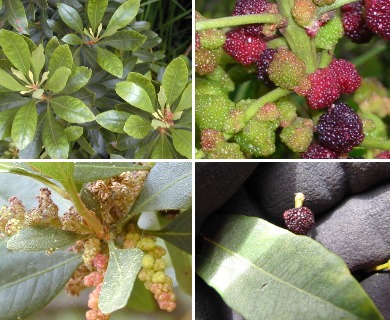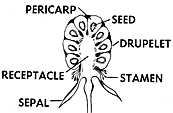Fayatree
Morella faya
Wax Myrtle family (Myricaceae)
Post-Cook introduction
introduced shrub or small tree, with many narrowly elliptical leaves, twigs and leaf surfaces with brown or yellow dot visible under a lens, and many dark red to blackish more than 1⁄4 inch (6 ) in diameter. Shrub or small tree to 40 feet (12 ) high and 10 inches (25 ) in trunk diameter. Bark brown to gray, smooth or becoming slightly fissured, inner bark greenish yellow, bitter. Twigs greenish, angled, with raised half-round leaf scars.

Forest And Kim Starr
Flower clusters (spikes) at leaf bases, 1⁄2–1 1⁄4 inches (1.3–3 ) long, unbranched. Flowers are many, stalkless, minute, male and female on the same plant (), without or each above a Male flowers are 3⁄16 inch (5 ) long, with four pinkish tinged Female flowers often joined together in groups of three above a
() many, stalkless along slender unbranched axes 3⁄4–2 1⁄4 inches (2–6 ) mostly back of leaves, round, more than 1⁄4 inch (6 ) in diameter, turning from greenish to dark red to blackish; the surface with many tiny round bead-like flesh reddish, almost tasteless. Seed single, brown, rounded, more than 1⁄8 inch (3 ) diameter.
Introduced into Hawaii as an ornamental probably by Portuguese settlers, who made wine from the and now naturalized in moist areas throughout the islands. It is especially common in the pasture land above the town of Paauilo on the Hamakua Coast of Hawaii. Also present and spreading at Hawaii Volcanoes National Park and on the fringes of the Alakai Swamp, Kauai, where it was planted in 1927 and again in 1940. Almost all plantings were made by the Division of Forestry in 1926 and 1927. Since 1940, it has been considered one of Hawaii’s most plants. A nitrogen fixer, it has the ability to take over the best pasture land by forming dense thickets. An active eradication program is underway but is a continuing struggle with the present system of poisoning and uprooting.
Special areas
Kokee, Volcanoes
Range
Native of Azores and Canary Islands
Other common names
firetree, fayabush, firebush
Botanical
Morella faya (Aiton) Wilbur





